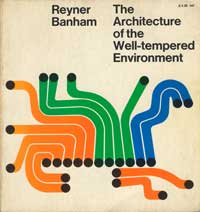
Rayner Banham
London, 1969.
In this history of architecture of the previous 100 years, Banham explores the technological developments in the unglamorous fields of ventilation, heating and lighting that have enabled the formal departures of 20th century design.
Though this is far from being a conservative's treatise, there are various passages which may serve as a counterweight to some of Fuller's arguments concerning the desirability of new materials for buildings. Banham reminds us, for instance, of some of the virtues of massive, as opposed to lightweight, structures:
"the mass of masonry in a fireplace, chimney-breast and chimney, has served to store the heat of the fire during the day while the fire burns, and to return it slowly to the house during the chill of the night, when the fire has burned out.
Alternatively, the thick walls of a house in a hot climate will hold solar heat during the day, slowing down the rate at which the interior becomes hot, and then, after sunset, the radiation of that heat into the house will help to temper the sudden chill of evening." (p.23)
Acoustic insulation is another important factor. Banham also provides a context for Fuller's complaints about Pre-Dymaxion Architecture, suggesting, in effect, that we be more understanding of the lags in technological practices:
"In their role as creators of actual physical environments, architects have to be both cautious and practical. They have to see something in use, sometimes for as much as a generation, before they feel the confidence to extrapolate new and radical uses for it, knowing that their clients will never forgive nor forget if anything goes wrong... So technological potential continuously runs ahead of architectural performance... Almost four decades separate the first industrial uses of air-conditioning from its confident employment in the kind of architecture that is designed by famous architects..." (p.28)
This remains a valuable book, and a great help to people not to judge a building by its cover.
© Paul Taylor 2000